While I was in Melbourne I stayed just a few blocks from the famous Fitzroy Gardens, and everyone told me that I simply must go visit Cooks’ Cottage “where Captain Cook was born.”
Exciting! An 18th century house in Australia, and one so closely linked to one of the most famous and influential explorers ever.
Wait, what?
Captain Cook wasn’t born in Australia!
And there weren’t European settlements in Australia until the 1780s! How could there be a proper stone cottage from 1750?
The answer is sad and prosaic.
The cottage was built in 1750, but not in its current location. It was built by Cook’s parents in England, sold in the 1930s, bought by a wealthy Australian, transported stone by stone to Melbourne, and re-assembled.
So really, it’s only kinda an 18th century cottage.
Darn.
And the news gets worse.
Despite what everyone in Melbourne (with the exception of the cottage staff) will tell you, Captain Cook wasn’t born in the cottage. It was built by his parents, but it was built when he was TWENTY SIX! Yeah. It’s very doubtful he ever lived in it – more likely he just visited.
Well, boo.
In fact, the closest the cottage really gets to Cook’s birth is a fragment of the column from the church he was baptised in in Merton, England.
Still, original or not it is the oldest building in Australia, and one of the few 18th century buildings I have ever seen (I really must get to Europe!).
The cottage is also fascinating in that it is a labourer’s house – Cook’s parents were simple farm workers, so even with 20th century plastering and a mish-mash of furniture, you got a clear sense of how ordinary people lived. The rooms are tiny, the staircase steep and narrow, the windows small.
The cottage was sort-of furnished, but I’m not enough of an expert on 18th century furniture and house fittings to confirm if they were accurate or not.
I can confirm that sadly, all the textiles associated with the cottage are not accurate. The visitors stopping through did seem to really enjoy the dress up box with its shiny white wigs and 1970s crocheted shawls, and that’s how my enthusiasm for costuming started as a young girl, so full points for that.
To be perfectly honest, the inaccurate textiles didn’t bug me – you wouldn’t want real 18th century textiles on display in open rooms with harsh antipoedean sunshine. What did bug me was this:
It’s based on a photograph of a pretend 18th century family in one of the cottage’s educational displays. The photograph is well…unfortunate…but if you are going to do a painting you can make anything up, so they could have at least drawn people in somewhat accurate and plausible garments. Even just garments that fit. Gah!
Ok. So that made me grumpy.
What made me happy was the garden – a reproduction 18th century cottage garden. Some of the labels referred more to 19th century flower symbology than 18th century concepts, but the plants were lovely, and the garden was suitably focused on food and health, and properly untidy.
Other good stuff:
The price. At $5 the entry fee properly balanced funding the house and being accessible to a reasonable range of people. It certainly seemed popular – there was a steady stream of visitors, mostly families with children,
And the staff were great – lovely and friendly and enthusiastic about their work. They were certainly excited about getting a visitor from Hawaii.
The verdict? A charming place to visit, particularly suited for families and children.

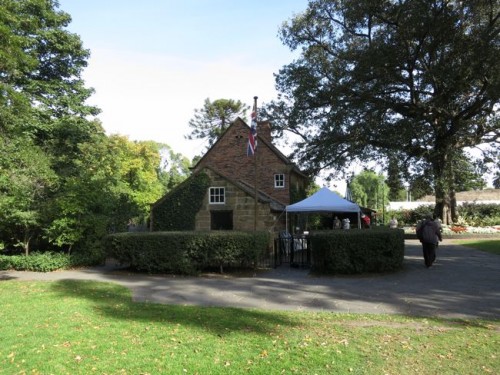
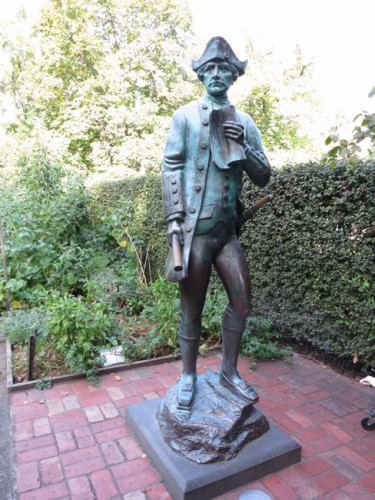
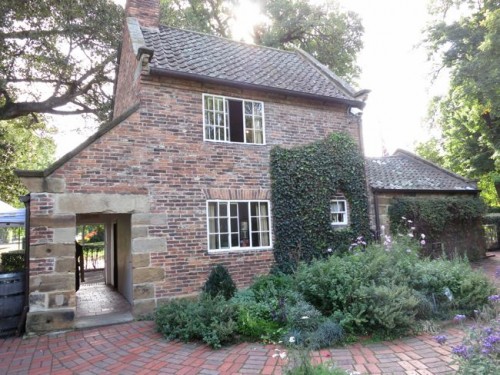
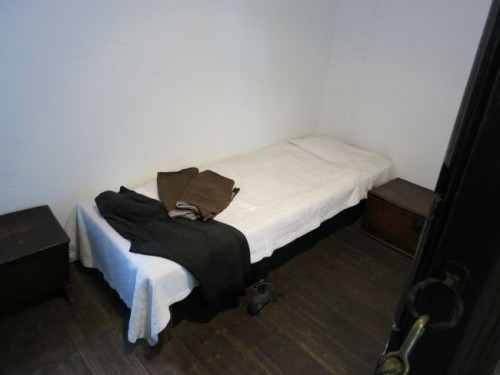
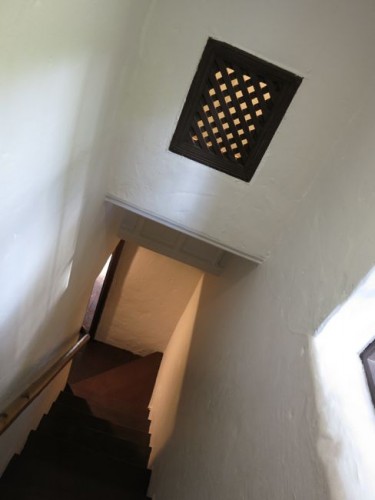
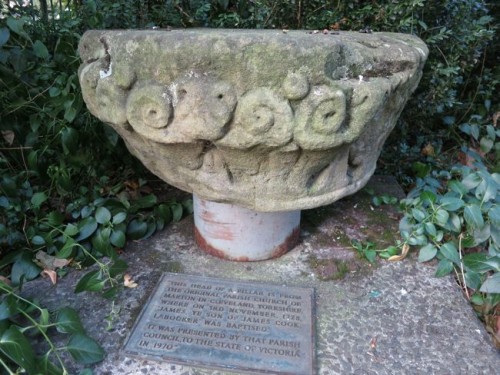

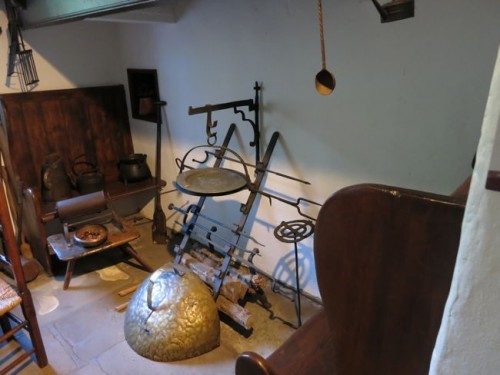
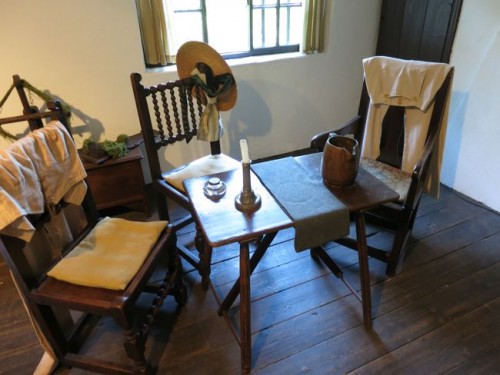
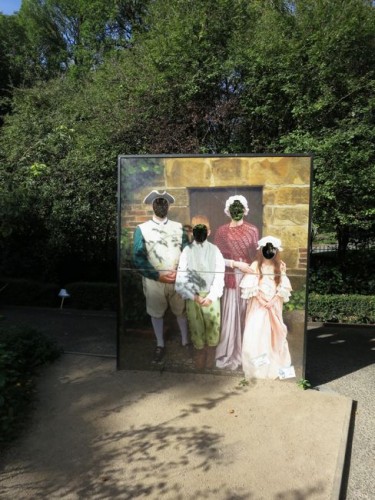
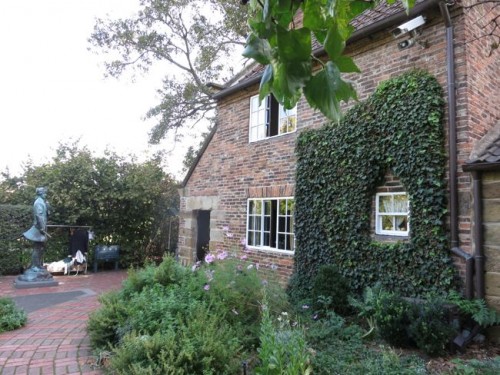
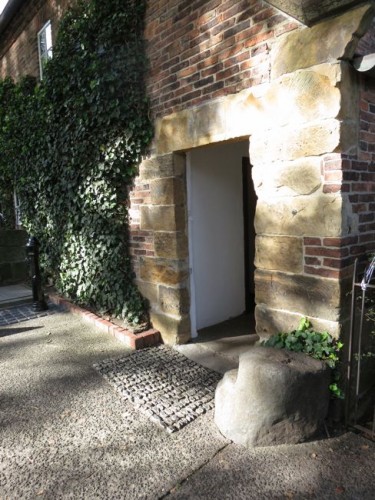
That is a horrible picture and I understand your annoyance with it.
Crappy costumes seem to be a common affliction of historical tourist sites like these. Here in new Brunswick we have “Kings landing historical settlement”, a fantastic Victorian village which also costs $5. It has everything, well, everything except decent costumes. If you visit their website you will be greeted by a picture of a lady in a red dress who is very obviously not wearing a corset and probably doesn’t have any petticoats or a shift either. Besides lacking proper underwear their costumes are ill fitting and untrimmed. They don’t seem to distinguish between decades and nobody has their hair put up properly.
The costumes are the only thing wrong with it though, it’s an amazing place to visit and definitely something to consider if you are in the Maritimes, it really does have everything. There are about ten houses plus several farms (complete with actors, animals and apple trees), a blacksmith, a carpenter, a cooper, a schoolhouse, a working sawmill and gristmill, stables(with oxen!), a couple of churches and a theater.
The buildings were mostly brought there from upriver to save them from flooding caused by dam construction. They are in very good shape and all filled with beautiful antiques. The landscape is also very good.
I really hope that didn’t sound too much like an advertisement. I’m only trying to be informative.
Oh no, I love hearing about fantastic places to visit – especially when it is somewhere I want to go! And your description is so vivid I almost ‘see’ it through your words.
Where would you go in Europe? I spent a year in southwest Germany and felt really at home. No 18th century buildings, though, since so much of Germany (especially that part) had been bombed to bits. I actually moved there from Hawaii, and found that vibe-wise, it reminded me so much of Honolulu–but colder. An old man I was talking story with told me that they used to sing a song about a beautiful young girl from Hawaii…before the war broke out.
So many parts of Germany and other countries still maintain scarring from various wars throughout the centuries. Not at all as picturesque as the cottage you visited in Australia. If I hadn’t been anti-war before, I certainly would have been after confronting real buildings that had been really damaged and imagining the people inside.
But that sort of authenticity brings so much character–and happy imaginings too. I really like churches that had been added on to through the centuries, and where you can see gothic, renaissance, and rococo all together! I suppose that it makes it easier for the costumers–any time period will do! (or, you can scrap your way into another career!)
Where would I go in Europe? Everywhere! There are so many places I want to visit. The UK for sure, France, Freisland, Croatia and Slovenia, the Czech Republic…
I’m trying to imagine Germany being like Hawaii. I wonder what the song they sang was?
I am from Germany, and have not been to Hawaii, so not sure how it would compare, but growing up in West-Berlin was like being on an island 😉
I did some googling, and one Hawaii related operetta from the 1930s came up, not sure if that’s the song Elise’s acquaintance meant. Here is the wikipedia link, it looks like something you’d appreciate in any case? (http://en.wikipedia.org/wiki/The_Flower_of_Hawaii)
The bomb damage all over Europe is sad, if it’s not one of the world wars, it’s from other conflicts (30 year war, Turkish wars, British Civil War etc.), but some stuff is still left.
Not that you lack destinations, but if you make it to the EU should visit Hungary, too! My husband is from there, so please write a blog post before you go to Europe, I’d be happy to give advice or even put you up! That would also count for Boston, if that’s not too stalkerish.
I will definitely post if I travel to Europe of the East Coast. I’d love to meet all the people I ‘know’ through blogging!
Thanks for the link to the operatta. I’ve never heard of it and it sounds fascinating. Pity the real story did not end so well 🙁
As you so rightly say, ‘Well, boo.’ At least they tried, I suppose, and I do have to applaud any effort, as long as it isn’t too misguided, to teach the young about their past, and with luck, catch their imaginations. It is a really nice wee cottage.
I don’t mind the reconstructed – the ‘three new heads and six new handles, but the same axe but the genuine axe of my great grand father’ school of antiquities. It works for some things. As long as we are told. In Europe, you find that so many of the buildings that look ancient were reconstructed after the war(s).
I was delighted to see that the ‘Cutty Sark’, one of the last great tea clippers, has been ‘relaunched’ in Greenwich after being badly damaged by fire. ‘Cutty Sark’ is a nice link back to this website – a sark is a shirt or chemise, and cutty meant short or curtailed, so a cutty sark is a short shirt, as in Robert Burns’ poem ‘Tam O’Shanter’, which is probably where the clipper’s name came from.
“three new heads and six new handles, but the genuine axe of my great grand father” – love it! I don’t mind the reconstruction, but would have enjoyed seeing that part of the story be integrated more – there wasn’t enough info on what was original and what wasn’t (and of course the house was lived in as a home for almost 2 centuries before it became a museum, and that gives a whole new layer of story and originality to ponder).
I followed the Cutty Sark story with interest too. Has it really been relaunched? As I understood it, it has sort of permanently been dry docked – almost ‘framed’ as a display.
Yes, it is in permanent dry dock – there were some photos somewhere of people walking around, admiring its underside.
Hahahahaha! I’m of the Lucy Worsley school: get people in and excited, and sort out the little details later.
Well there’s something for you to do in your dotage, Dreamstress – advise all the historical villages on proper costuming! Many of those places are run by enthusiastic volunteers, so the knowledge base is varied.
Have you been to Whanganui yet? There is an old steam paddleboat there that runs up the river, about an hour in each direction. It would be an awesome daytrip with fellow costumers, just don’t dress in anything pale as the ash from the smokestacks gets everywhere.
riverboats.co.nzhttp://www.riverboats.co.nz/
I’ve definitely thought of that! And I try to help/advise without being annoying and patronising when I am at small local museums.
I’ve spent lots of time in Whanganui (I highly approve of your ‘h’ btw!) as Nana lived there, but we were always visiting Nana, so I’ve not done much sightseeing. I definitely want to do the paddleboat tour. Good to know about the ash.
I’m with Hayley on that. Even the paid ones come from different back grounds. At our old fort, the tour guides are usually university students (ie still learning themselves…not masters of their trade). Some are majoring in history, some in textiles, some in drama, some in languages, some in tourism. If you are a spanish speaking tourist, you will be thrilled to have a spanish speaking tour guide but that guide has no concept of history and is only spouting back what they can remember from the script they were given at the begining of the season. The real troubles come from the questions or comments that deviate from the script. Even the ones that are interested in history can tell different stories and versions of the facts based on their sources and particular twists of interest.
At our smaller venues, it is volunteers. If I volunteered at one of them MY particular slant of interest would be in the clothing. But, I’m not formally trained and tested. Any misinformation I’ve gathered or facts I’ve remembered incorrectly would be happily passed on with the greatest of good intensions.
I’m just grateful these places are still standing and the efforts and memories of the builders are not completely wiped out.
Oh yes, I completely understand that! That’s why I’m just pleased that the staff was friendly and enthusiastic. 🙂
Gosh the inside definitely doesn’t look authentic, too square and neat. That’s what really struck me about the old buildings in England -nothing but nothing is square, clean, level etc. Floors meander, join in odd ways, and all is uneven. It’s fantastic! 🙂
It Is cool though – I remember as a lass going to Cobblestones in Greytown many times and enjoying the displays, which were also probably a mishmash. But it all interested me in history and I love how it reflects the whole age of a house – like as you said the house was lived in for another 200 years.
i recall an episode of grand designs where the couple were restoring an 800 year old guild hall, and Kevin McCloud was concerned that by stripping back the intervening 800 years of history they were doing a disservice. It is something that had never occurred to me before, given in NZ restoring a house to its original state usually means taking the 1970’s renos out of a 1930’s house, not taking the 1670 renos out of a 1230s house! 🙂
There is a a few houses I have been to where the vast majority of the house is done up to the era it was built in but the odd bedroom is done up in some era between then and now. In reality, if a house is 200 years old, what it was like 150 years ago is part of its history. If, in one of its incarnations it was a hospital for wounded soldiers, there is no crime in having one room reflect that. In a way it is a bit of a crime not to show that.
You inspired me to go to Cook’s Cottage this very afternoon (as it’s sunny and I’m ‘between jobs’ again). I loved how they never once said that he wasn’t born in the cottage. Clever, clever. But all in all, it was a nice $5 historical interlude in my day.